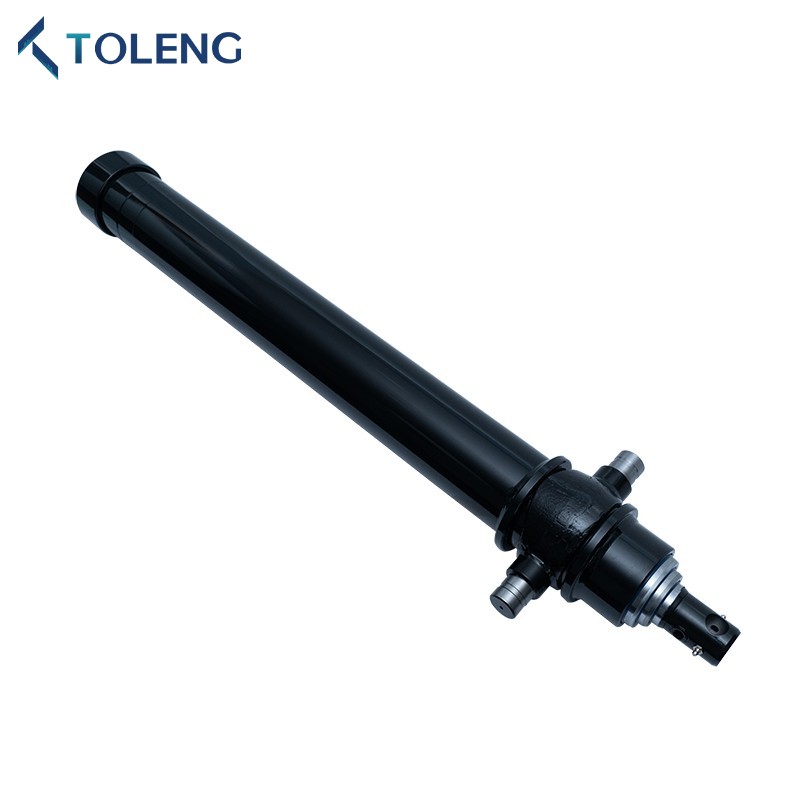Which type of hydraulic cylinder is more efficient for dump trucks?
2025-07-23
As a core component of the hydraulic system of dump trucks, the performance of the hydraulic cylinder directly affects the working efficiency and stability of the dump truck. Selecting an efficient dump truck hydraulic cylinder requires a comprehensive consideration of multiple factors, including the structural design, material selection, sealing performance, pressure resistance, and service life of the cylinder. The following will analyze the characteristics of different models of dump truck hydraulic cylinders from multiple perspectives to help you choose a more efficient product.

Basic Structure and Working Principle of Dump Truck Cylinders
The dump truck hydraulic cylinder is usually composed of components such as the barrel, piston, piston rod, seals and guide sleeves. Its working principle is that the high-pressure oil provided by the hydraulic system pushes the piston to move, thereby lifting and lowering the cargo box of the dump truck. The performance of the cylinder directly determines the lifting speed, carrying capacity and operational stability of the dump truck.
The Key Factors Affecting the Efficiency of the Dump Truck Hydraulic Cylinder
1.The bore and stroke of the cylinder
The bore and stroke of the cylinder are key parameters that determine its output force and lifting height. The larger the bore, the greater the output force of the cylinder, but it also requires higher pressure support from the hydraulic system. The longer the stroke, the higher the lifting height of the cylinder, but an excessively long stroke may lead to a decrease in the cylinder's stability and bending resistance. Therefore, the selection of an appropriate bore and stroke needs to be optimized based on the specific usage scenarios of the dump truck.
2. Materials and Manufacturing Process of the Cylinder
The cylinder barrel and piston rod of the oil cylinder are usually made of high-strength alloy steel to ensure their resistance to deformation and wear at high pressures. High-quality manufacturing processes (such as precision machining and heat treatment) can significantly improve the sealing performance and durability of the dump truck hydraulic cylinder. For instance, the piston rod that has undergone surface hardening treatment can better resist wear and corrosion, thereby extending the service life of the oil cylinder.
3. Performance of Sealing Components
The sealing component is one of the most crucial parts in an hydraulic cylinder. Its performance directly affects the sealing effect of the oil cylinder and the efficiency of the hydraulic system. High-quality sealing components can effectively prevent the leakage of hydraulic oil, reduce energy loss, and maintain stable performance even under high pressure and high temperature conditions. Common sealing materials include polyurethane, nitrile rubber, and fluororubber, and different materials are suitable for different working environments and types of hydraulic oil.
4. The pressure resistance and stability of the hydraulic cylinder
During the operation of the dump truck, the hydraulic cylinder needs to withstand significant pressure and impact loads. Therefore, the design of the hydraulic cylinder must possess excellent pressure resistance and stability. For instance, a hydraulic cylinder with a double-layer cylinder barrel structure or reinforced ribs can maintain better rigidity and stability under high pressure, reducing the risk of deformation and damage to the cylinder.
5. Installation method and connection components of the cylinder
The installation method and design of the connection components of the cylinder also affect its working efficiency. For instance, cylinders using ball-joint connections or flange connections can better adapt to the angle changes of the dump truck during lifting, reducing the lateral load and wear on the cylinder. Moreover, a proper installation position and support structure can enhance the working efficiency and service life of the cylinder.
How to Select an Efficient Dump Truck Hydraulic Cylinder
1.Choose based on the usage scenarios of the dump truck
Different usage scenarios have different requirements for the performance of the oil cylinder. For example, in heavy-load scenarios such as mines and construction sites, heavy-duty oil cylinders with strong pressure resistance and good stability need to be selected; while in urban sanitation and light-duty transportation vehicles, lightweight oil cylinders can be chosen to improve fuel economy.
2.Select based on the parameters of the hydraulic system
The cylinder diameter, stroke length and output force should be selected to match the pressure, flow rate and power of the hydraulic system. Choosing a cylinder that does not match the parameters of the hydraulic system may result in low system efficiency or damage to the cylinder.
3. Consider the maintenance and replacement costs of the hydraulic cylinders
Efficient dump truck hydraulic cylinders not only need to perform well in terms of performance, but also need to have advantages in maintenance and replacement costs. Choosing hydraulic cylinders that are easy to maintain and have convenient replacement of seals can reduce the long-term usage costs.
When choosing an efficient dump truck hydraulic cylinder, various factors such as the structural design, material selection, sealing performance, pressure resistance capability, and installation method of the cylinder need to be comprehensively considered. Different usage scenarios and hydraulic system parameters have different requirements for the performance of the cylinder. Users should select the appropriate cylinder model based on specific needs. By optimizing the design and manufacturing process of the cylinder, the working efficiency and service life of the dump truck can be improved, maintenance costs can be reduced, and thus greater economic benefits can be brought to users. TOLENG will provide you with hydraulic cylinders that meet your expectations. If you need them, please contact us.

























